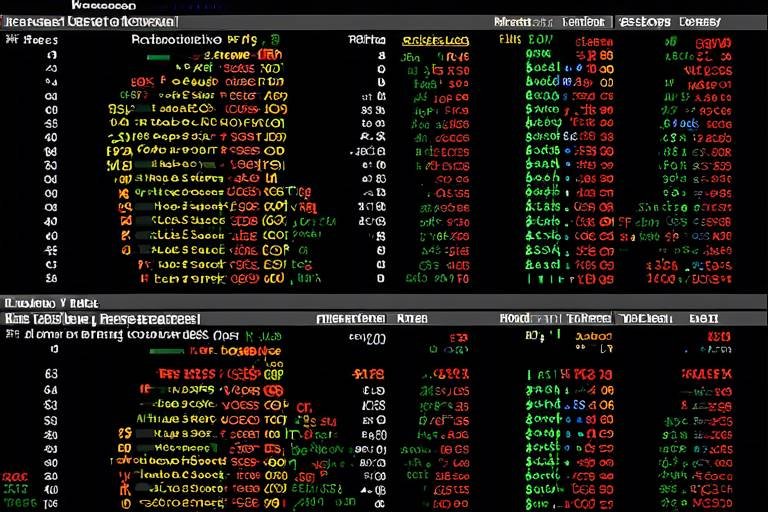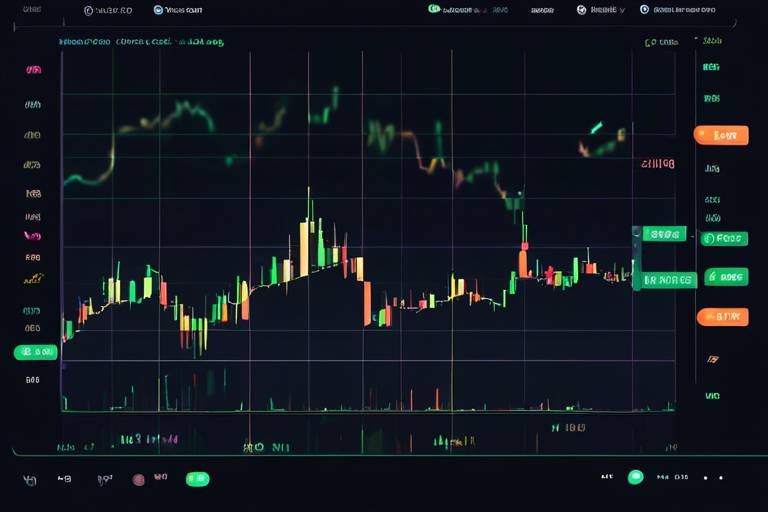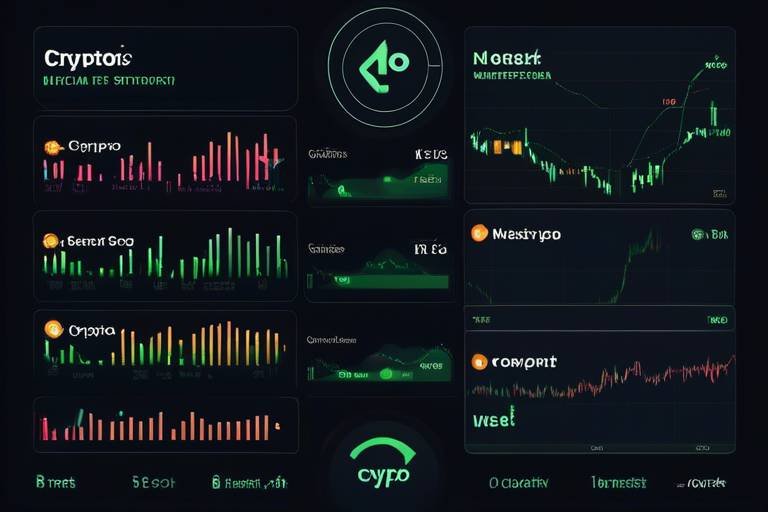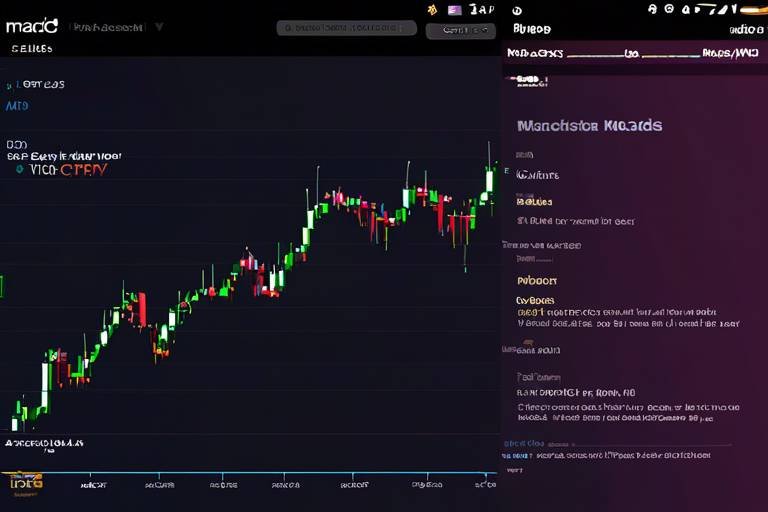How to Develop a Risk-Reward Strategy in Crypto Trading
In the fast-paced world of crypto trading, where fortunes can be made or lost in the blink of an eye, having a well-defined risk-reward strategy is essential. Imagine standing on the edge of a cliff, peering into the vast ocean of possibilities below. You wouldn’t jump without a parachute, right? Similarly, before diving into the crypto market, you need a safety net—a strategy that helps you balance potential profits against the risks you’re willing to take. This article will explore the essential components of creating a risk-reward strategy that not only maximizes profits but also minimizes potential losses through disciplined planning and analysis.
The risk-reward ratio is a fundamental concept in trading, acting as a compass that guides investors in evaluating potential returns against the risks involved. Think of it as a scale: on one side, you have the potential gains, and on the other, the possible losses. A clear understanding of this ratio aids in making informed trading decisions. For instance, if you’re risking $100 to potentially gain $300, your risk-reward ratio is 1:3. This means for every dollar you risk, you stand to gain three. The key takeaway? Always aim for a risk-reward ratio that supports your trading objectives.
Establishing clear trading goals is vital for any strategy. Goals should be specific, measurable, achievable, relevant, and time-bound (SMART). This framework provides a structured approach for assessing performance and adjusting strategies as necessary. For example, instead of saying, "I want to make money," a SMART goal would be, "I aim to achieve a 20% return on my investment within the next six months." This clarity not only keeps you focused but also helps in evaluating your progress.
Differentiating between short-term and long-term goals helps traders align their strategies with their investment horizon. Short-term goals may focus on quick gains from day trading, while long-term goals could involve holding onto assets for several months or years. This alignment allows for tailored approaches that suit different market conditions and personal risk tolerance. It's like choosing between a sprint and a marathon—both require different training and mindsets.
Understanding market trends is essential for setting realistic goals. Traders should analyze historical data and current market sentiments to forecast potential price movements. Tools like charts and technical indicators can help paint a clearer picture of where the market might head. For instance, if you notice a bullish trend, it might be an opportune time to set higher profit targets.
Regularly reviewing and adjusting goals based on trading performance ensures that strategies remain relevant and effective. This adaptive approach helps traders stay aligned with their risk-reward objectives. If you find yourself consistently missing your targets, it might be time to reassess your strategy or adjust your goals. Remember, flexibility is key in the ever-evolving landscape of crypto trading.
Effective risk management techniques are critical for protecting capital. Implementing stop-loss orders and position sizing can significantly reduce potential losses while allowing traders to capitalize on profitable opportunities. A stop-loss order acts like a safety net, automatically selling your asset when it reaches a certain price, thus limiting your losses. Position sizing, on the other hand, involves determining how much of your capital to risk on a single trade. This way, you can manage your exposure and safeguard your investments.
Selecting appropriate technical indicators can enhance the effectiveness of a risk-reward strategy. Indicators provide insights into market conditions, helping traders make informed decisions about entry and exit points. For instance, the Moving Average can help smooth out price data, making it easier to spot trends, while the Relative Strength Index (RSI) can indicate whether an asset is overbought or oversold.
Familiarity with popular technical indicators can aid traders in analyzing price movements. Here’s a quick rundown of some commonly used indicators:
- Moving Averages: Helps identify trends.
- Relative Strength Index (RSI): Indicates overbought or oversold conditions.
- Bollinger Bands: Measures market volatility.
Combining multiple indicators can provide a more comprehensive view of market conditions. This approach can enhance decision-making and improve the overall effectiveness of a risk-reward strategy in crypto trading. For example, using both the RSI and Moving Averages together can help confirm trends and entry points, giving you a stronger basis for your trades.
Continuous review and adaptation of strategies are essential for long-term success in crypto trading. Analyzing past trades allows traders to identify patterns and make necessary adjustments to improve future performance. It’s akin to a sports team reviewing game footage to refine their tactics. By understanding what worked and what didn’t, you can fine-tune your approach, ultimately leading to better results.
Q: What is a good risk-reward ratio for crypto trading?
A: A commonly recommended risk-reward ratio is 1:2 or higher, meaning for every dollar you risk, you aim to gain at least two dollars.
Q: How do I set stop-loss orders?
A: You can set stop-loss orders through your trading platform by specifying the price at which you want to automatically sell your asset to limit losses.
Q: Can I adjust my risk-reward strategy over time?
A: Yes! It’s crucial to regularly review and adjust your strategy based on market conditions and your trading performance.

Understanding Risk-Reward Ratio
The risk-reward ratio is a fundamental concept in trading, particularly in the volatile world of cryptocurrency. It serves as a guiding light, helping traders assess the potential returns of a trade relative to the risks they are taking. Imagine you're standing at the edge of a cliff, weighing the thrill of jumping into the unknown against the fear of falling. That's the essence of the risk-reward ratio—it's all about balancing excitement with caution.
To put it simply, the risk-reward ratio is calculated by dividing the amount of profit you expect to make from a trade by the amount you are willing to lose. For example, if you're eyeing a trade where you anticipate making $300 but are willing to risk $100, your risk-reward ratio would be 3:1. This means for every dollar you risk, you stand to gain three. This ratio not only helps you evaluate the attractiveness of a trade but also instills a sense of discipline in your trading strategy.
Understanding this ratio is crucial because it can significantly influence your trading decisions. A common mistake among traders is to focus solely on the potential gains without adequately considering the risks involved. This oversight can lead to poor decision-making and substantial losses. Therefore, it's essential to establish a benchmark for your risk-reward ratio before entering any trade. Many successful traders aim for a ratio of at least 2:1 or 3:1, ensuring that their potential rewards outweigh their risks.
Moreover, it's important to remember that the risk-reward ratio is not set in stone. It can change based on market conditions, your trading style, and your individual risk tolerance. For instance, during a bullish market, some traders might be willing to accept a lower risk-reward ratio because they believe the potential for profit is higher. Conversely, in a bearish market, they might opt for a more conservative approach, aiming for a higher ratio to safeguard their capital.
To further illustrate the concept, consider the following table that compares different risk-reward scenarios:
| Scenario | Risk ($) | Reward ($) | Risk-Reward Ratio |
|---|---|---|---|
| Scenario A | $100 | $300 | 3:1 |
| Scenario B | $150 | $300 | 2:1 |
| Scenario C | $200 | $200 | 1:1 |
As you can see, Scenario A offers the most favorable risk-reward ratio, making it a more attractive option for traders looking to maximize their profits while minimizing losses. This highlights the importance of not just looking at potential rewards, but also critically evaluating the risks involved.
In conclusion, mastering the risk-reward ratio is a vital skill for any trader venturing into the world of cryptocurrency. By understanding and applying this concept, you can make more informed trading decisions, enhance your overall strategy, and ultimately increase your chances of success in this exciting yet unpredictable market.

Setting Clear Goals
When it comes to crypto trading, setting clear goals is not just a suggestion; it’s a necessity. Imagine trying to navigate a ship without a destination—chaotic, right? In the same way, without defined goals, your trading journey can quickly turn into a turbulent ride. Goals act as your compass, guiding you through the unpredictable waters of the crypto market. They should be specific, measurable, achievable, relevant, and time-bound (SMART). This framework not only helps you stay focused but also allows you to assess your performance and adjust your strategies as needed.
To set effective goals, start by asking yourself what you truly want to achieve in your trading journey. Are you looking to build wealth over time, or do you prefer quick gains? This fundamental understanding will help shape your approach. For instance, if your aim is to accumulate wealth, you might focus on long-term investments and strategies that emphasize growth. On the other hand, if you’re in it for the thrill of quick trades, your goals will likely revolve around short-term gains.
It's also crucial to differentiate between short-term and long-term goals. Short-term goals might include making a certain percentage profit within a week or successfully executing a specific number of trades. Long-term goals, however, could be more expansive, like doubling your investment over the next year. Understanding these distinctions allows you to tailor your strategies to align with your investment horizon, ensuring they suit both your market conditions and your personal risk tolerance.
Now, here’s where it gets interesting—setting realistic goals also requires a keen eye on the market trends. Analyzing historical data and current market sentiments is essential for forecasting potential price movements. For example, if you notice a consistent upward trend in a particular cryptocurrency, it might be a good time to set a goal to invest a certain amount, anticipating further growth. Conversely, if the market is showing signs of volatility, you may want to adjust your goals to minimize risk.
But wait, it doesn't stop there! Regularly reviewing and adjusting your goals based on your trading performance is crucial. Think of it as a fitness regimen—if you’re not seeing results, you wouldn’t stick to the same routine, right? The same logic applies to trading. By consistently analyzing your trades, you can identify what works and what doesn’t, allowing you to refine your goals and strategies accordingly. This adaptive approach ensures that you remain aligned with your risk-reward objectives, ultimately paving the way for sustained success.
In conclusion, setting clear goals in crypto trading is not merely a box to check off; it’s the foundation of a successful trading strategy. By defining your objectives and regularly evaluating your progress, you’ll not only stay focused but also enhance your overall trading experience. Remember, in the world of crypto, clarity is power!
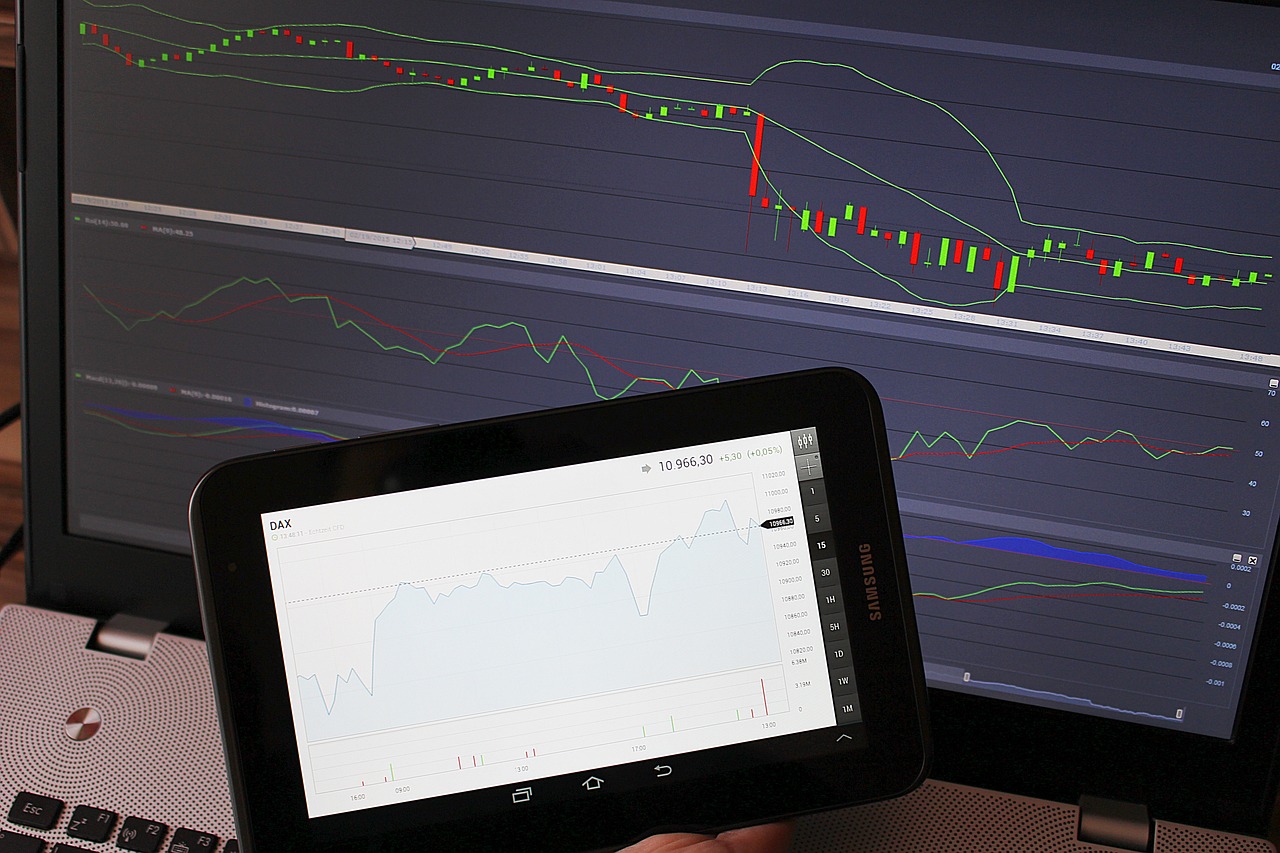
Short-Term vs. Long-Term Goals
When it comes to crypto trading, understanding the distinction between short-term and long-term goals is crucial for crafting a successful risk-reward strategy. Think of short-term goals as the sprint in a marathon; they require quick decisions and immediate actions, while long-term goals represent the endurance needed to cross the finish line. By clearly defining these two types of goals, traders can align their strategies with their investment horizons, ensuring that they are adequately prepared for the ups and downs of the crypto market.
Short-term goals often focus on quick wins and capitalize on market volatility. Traders may aim for specific percentage gains within a day or week, taking advantage of price fluctuations to maximize profits. For instance, a trader might set a goal to achieve a 10% return on a particular cryptocurrency within a week. This approach can be exciting, but it also requires a keen eye on market trends and the ability to react swiftly to changes.
On the flip side, long-term goals are more about building wealth over time. They require patience, discipline, and a well-thought-out plan. A trader might set a goal to hold onto an asset for several months or even years, aiming for a substantial return as the market matures. For example, a long-term goal could be to accumulate a specific amount of Bitcoin over the next five years, regardless of short-term market fluctuations. This strategy allows traders to ride out the inevitable volatility that comes with crypto trading.
To effectively manage both short-term and long-term goals, traders should consider the following:
- Risk Tolerance: Determine how much risk you are willing to take for each type of goal. Short-term goals might involve higher risks, while long-term goals may prioritize stability.
- Market Analysis: Regularly analyze market trends to inform your goals. Short-term traders need to be agile and responsive, while long-term traders should focus on broader market patterns.
- Performance Tracking: Keep track of your progress towards both short-term and long-term goals. This will help you adjust your strategies as needed and stay committed to your overall trading plan.
Ultimately, the balance between short-term and long-term goals can create a well-rounded trading strategy that maximizes potential profits while minimizing risks. By understanding your own trading style and aligning your goals accordingly, you can navigate the unpredictable waters of crypto trading with greater confidence.
1. Why are short-term goals important in crypto trading?
Short-term goals allow traders to take advantage of market volatility and achieve quick profits, which can be reinvested or used to offset potential losses.
2. How do I set effective long-term goals?
Effective long-term goals should be specific, measurable, achievable, relevant, and time-bound (SMART). This framework helps you stay focused and adjust your strategies as needed.
3. Can I have both short-term and long-term goals simultaneously?
Absolutely! Many successful traders balance both types of goals, using short-term strategies to capitalize on immediate opportunities while maintaining a long-term investment perspective.

Evaluating Market Trends
When it comes to crypto trading, understanding market trends is like having a compass in an uncharted territory. Without it, you could easily find yourself lost, wandering through volatility without a clear direction. So, how do you evaluate these trends effectively? It starts with a combination of historical data analysis and an acute awareness of current market sentiments.
First off, diving into historical data is essential. Look back at previous price movements and identify patterns. For instance, you might notice that Bitcoin tends to rally after a certain percentage drop. By recognizing these patterns, you can formulate a strategy that anticipates potential price movements. Remember, the past can often give clues about the future, but it’s not a guarantee.
Next, tapping into current market sentiments is equally crucial. This involves staying updated with the latest news, social media buzz, and community discussions. Platforms like Twitter and Reddit can provide real-time insights into what traders are feeling. Are they bullish or bearish? A sudden surge in positive sentiment can indicate a potential upward trend, while negativity might suggest a downturn.
To further enhance your analysis, consider the following methods:
- Technical Analysis: Utilize tools like candlestick charts and trend lines to visualize price movements.
- Fundamental Analysis: Keep an eye on project developments, partnerships, and regulatory news that could impact prices.
- Sentiment Analysis: Gauge the mood of the market through social media and news outlets.
Moreover, it's essential to stay adaptable. Market trends can change rapidly, and what worked yesterday might not work today. Regularly revisiting your analysis and adjusting your strategies accordingly ensures that you remain aligned with the ever-evolving landscape of crypto trading. Just like a seasoned sailor adjusts their sails to the shifting winds, you too must be prepared to pivot your approach based on the latest market conditions.
Lastly, consider creating a simple table to track your findings and observations over time. Here’s a quick example:
| Date | Market Sentiment | Price Movement | Notes |
|---|---|---|---|
| 01/01/2023 | Bullish | +10% | Positive news on adoption |
| 01/15/2023 | Bearish | -5% | Regulatory concerns |
In conclusion, evaluating market trends is not just about crunching numbers; it’s about understanding the heartbeat of the market. By combining data analysis with sentiment awareness, you can navigate the unpredictable waters of crypto trading more effectively, ultimately leading to better-informed decisions and a more robust risk-reward strategy.

Adjusting Goals Based on Performance
In the world of crypto trading, flexibility is key. Just like a seasoned sailor adjusts their sails to navigate changing winds, traders must be willing to reassess their goals based on their performance. It’s not just about setting targets and hoping for the best; it’s about being proactive and responsive to the market dynamics. Regularly reviewing your trading results can illuminate patterns and trends that you might not have noticed otherwise. This practice not only helps in fine-tuning your strategies but also ensures that you remain aligned with your risk-reward objectives.
So, how do you go about adjusting your goals? First, it’s essential to establish a routine for performance evaluation. Consider setting aside time weekly or monthly to review your trades. During this evaluation, ask yourself some critical questions:
- Did I meet my profit targets?
- Were my risk management strategies effective?
- What patterns can I identify in my successful trades versus my losses?
By answering these questions, you can gain valuable insights into your trading behavior. For instance, if you consistently miss your profit targets, it might be time to reassess your risk-reward ratios or even your entry and exit strategies. Conversely, if you find that you’re hitting your targets but taking on too much risk, you may want to tighten your stop-loss orders or adjust your position sizes.
Moreover, it’s crucial to keep an eye on the market conditions. The crypto market is notoriously volatile, and what worked yesterday may not work today. If the market shifts dramatically, your previously set goals might become unrealistic. Therefore, it’s wise to stay informed about market news and trends, as they can significantly impact your trading strategy.
Finally, remember that adjusting goals is not a sign of weakness; it’s a strategic move that showcases your commitment to growth and improvement. Embrace the learning process, and don’t hesitate to pivot when necessary. By continuously refining your goals based on performance, you’ll be better equipped to navigate the unpredictable waters of crypto trading.
- What is a risk-reward ratio? The risk-reward ratio is a measure used by traders to compare the potential profit of a trade to the potential loss. A favorable ratio helps in making informed trading decisions.
- How often should I adjust my trading goals? It’s advisable to review your trading goals regularly, such as weekly or monthly, to ensure they remain relevant and achievable based on your performance and market conditions.
- What are some effective risk management techniques? Common techniques include setting stop-loss orders, diversifying your portfolio, and determining appropriate position sizes based on your capital and risk tolerance.

Risk Management Techniques
When it comes to crypto trading, effective risk management is your best friend. Imagine you're sailing on a vast ocean; without a sturdy ship and a good map, you're likely to run aground. Similarly, in the world of cryptocurrency, having a solid risk management strategy can keep you afloat amidst the waves of volatility. One of the key techniques is the use of stop-loss orders. This tool acts like a safety net, automatically selling your assets when they reach a certain price. This way, you can limit potential losses without having to monitor your trades constantly. Think of it as setting a boundary to protect your investment; once the price dips below that line, you're out, minimizing the damage.
Another critical aspect of risk management is position sizing. This involves determining how much of your total capital you're willing to risk on a single trade. By calculating the appropriate position size, you can ensure that no single trade will significantly impact your overall portfolio. A common rule of thumb is to risk no more than 1-2% of your total capital on any one trade. This approach not only protects your account but also gives you the confidence to make decisions without the fear of losing everything on a single trade.
In addition to stop-loss orders and position sizing, it's important to keep an eye on market conditions. The crypto market is known for its unpredictability, and factors such as news, regulatory changes, and market sentiment can all influence price movements. By staying informed and adjusting your strategies accordingly, you can better manage your risks. For instance, if you notice that a significant news event is about to occur, you might choose to tighten your stop-loss orders or reduce your position size to protect yourself from sudden market shifts.
Moreover, you can enhance your risk management strategy by utilizing a combination of different techniques. For example, you might employ both stop-loss orders and trailing stops. A trailing stop allows you to lock in profits as the price moves in your favor while still providing a safety net if the market reverses. This dual approach can be particularly effective in the volatile crypto market, where prices can swing dramatically in a short period.
To summarize, a robust risk management strategy in crypto trading involves:
- Utilizing stop-loss orders to limit losses.
- Calculating position sizes to manage risk effectively.
- Staying informed about market conditions and adjusting strategies.
- Combining techniques like trailing stops for enhanced protection.
By implementing these techniques, you can navigate the turbulent waters of crypto trading with greater confidence and security. Remember, the goal isn't just to maximize profits but to protect your capital and ensure long-term success in this exciting yet unpredictable market.
- What is a stop-loss order? A stop-loss order is an instruction to sell a security when it reaches a certain price, helping to limit potential losses.
- How do I determine the right position size? You can calculate your position size based on your total capital and the percentage of risk you are willing to take on a single trade.
- Why is risk management important in crypto trading? Effective risk management helps protect your capital from significant losses, allowing you to trade with confidence and pursue long-term success.

Choosing the Right Indicators
When it comes to crypto trading, the right indicators can be your best friends. They act like a compass, guiding you through the often tumultuous waters of the market. But with so many indicators out there, how do you choose the ones that will actually help you make informed decisions? It's all about understanding what each indicator does and how it fits into your overall risk-reward strategy.
Firstly, it's essential to recognize that indicators can be broadly categorized into two types: trend indicators and momentum indicators. Trend indicators, such as Moving Averages, help you identify the direction of the market over a specific period. On the other hand, momentum indicators, like the Relative Strength Index (RSI), measure the speed and change of price movements, giving you insights into potential reversals or continuations in price trends.
To illustrate the difference, consider the following table:
| Indicator Type | Example | Purpose |
|---|---|---|
| Trend Indicator | Moving Average | Identifies the overall direction of the market |
| Momentum Indicator | Relative Strength Index (RSI) | Measures the speed and change of price movements |
Choosing the right indicators is not just about picking popular ones; it’s about finding what resonates with your trading style. Are you a day trader looking for quick gains, or a long-term investor who prefers to ride out the market's ups and downs? Your answers will guide your selection. For instance, day traders might lean towards indicators that provide quick signals, while long-term investors may prefer those that smooth out short-term volatility.
Moreover, combining indicators can provide a more nuanced view of market conditions. For example, you might use a Moving Average to identify the trend and the RSI to confirm whether the asset is overbought or oversold. This combination can enhance your decision-making process, allowing you to enter or exit trades with greater confidence.
However, be cautious! Overloading your trading strategy with too many indicators can lead to analysis paralysis. It’s essential to strike a balance. A good rule of thumb is to limit yourself to a few indicators that you understand well and that complement each other. This way, you can maintain clarity in your analysis while still benefiting from the insights that indicators provide.
In summary, choosing the right indicators is a crucial step in developing a successful risk-reward strategy in crypto trading. By understanding the purpose of each indicator, aligning them with your trading goals, and combining them wisely, you can significantly enhance your trading performance. Remember, the goal is to make informed decisions that align with your risk tolerance and investment objectives.
- What are the most popular indicators for crypto trading? Some of the most popular indicators include Moving Averages, RSI, MACD, and Bollinger Bands.
- How many indicators should I use? It's generally recommended to use 2-3 indicators that complement each other to avoid confusion.
- Can I rely solely on indicators for trading decisions? While indicators provide valuable insights, it's essential to consider other factors like market news and personal research.

Popular Technical Indicators
When it comes to crypto trading, understanding technical indicators can be a game-changer. These indicators serve as your compass, guiding you through the often turbulent waters of the cryptocurrency market. They help you analyze price movements, identify trends, and make informed decisions about your trades. Some of the most popular technical indicators that traders rely on include Moving Averages, Relative Strength Index (RSI), and Bollinger Bands. Each of these indicators has its unique strengths and can be used in various ways to enhance your trading strategy.
The Moving Average is one of the simplest yet most effective indicators. It smooths out price data to create a trend-following indicator, which can help you identify the direction of the market. For instance, a 50-day moving average can indicate the medium-term trend, while a 200-day moving average can show the long-term trend. Traders often look for crossovers between short-term and long-term moving averages as potential buy or sell signals.
Next, we have the Relative Strength Index (RSI), a momentum oscillator that measures the speed and change of price movements. The RSI ranges from 0 to 100 and is typically used to identify overbought or oversold conditions in a market. A reading above 70 usually indicates that a cryptocurrency is overbought, while a reading below 30 suggests it is oversold. This can be crucial for traders looking to enter or exit positions at optimal times.
Another valuable tool is the Bollinger Bands, which consist of a middle band (the moving average) and two outer bands that are standard deviations away from the middle band. This indicator helps traders understand volatility in the market. When the bands contract, it suggests that the market is experiencing low volatility, while expansion indicates high volatility. Traders often look for price movements that touch or break the bands as potential signals for entering or exiting trades.
Combining these indicators can yield even better results. For example, using the RSI in conjunction with Moving Averages can provide a more robust analysis. If the RSI indicates that a cryptocurrency is oversold while the price is near a significant moving average support level, it might be a strong signal to consider entering a trade.
In summary, familiarizing yourself with popular technical indicators is essential for developing a successful risk-reward strategy in crypto trading. By leveraging tools like Moving Averages, RSI, and Bollinger Bands, traders can gain deeper insights into market conditions and make more informed trading decisions.
- What are technical indicators? Technical indicators are mathematical calculations based on price and volume data that traders use to forecast future price movements.
- How do I choose the right technical indicators? The right indicators depend on your trading style and goals. Start with a few and see which ones resonate with your trading approach.
- Can I rely solely on technical indicators for trading? While technical indicators are helpful, it's essential to consider other factors like market news and fundamentals for a well-rounded trading strategy.

Combining Indicators for Better Insights
In the fast-paced world of crypto trading, relying on a single technical indicator can often lead to misleading conclusions. Just like a detective needs multiple clues to solve a mystery, traders benefit immensely from combining indicators to gain a clearer picture of market dynamics. By using a blend of indicators, you can enhance your decision-making process, allowing you to navigate the volatile crypto landscape with greater confidence.
Imagine you’re trying to find your way through a dense forest. If you only have a compass, you might get lost along the way. However, if you also have a map and a GPS, your chances of reaching your destination increase significantly. Similarly, in trading, using various indicators can provide a more comprehensive view of the market. For instance, combining a trend-following indicator like the Moving Average with a momentum indicator like the Relative Strength Index (RSI) can help you identify both the direction of the trend and the strength of that trend.
To make the most out of your trading strategy, consider these popular combinations:
- Moving Average + RSI: Use the Moving Average to identify the trend and the RSI to determine whether the asset is overbought or oversold.
- Bollinger Bands + MACD: Bollinger Bands can show volatility while the MACD (Moving Average Convergence Divergence) helps in spotting potential reversals.
- Fibonacci Retracement + Volume Indicators: This combination can assist in identifying potential support and resistance levels while confirming the strength of those levels with trading volume.
When combining indicators, it’s crucial to avoid redundancy. Using multiple indicators that provide the same information can lead to analysis paralysis, where too much information clouds your judgment. Instead, aim for a mix of indicators that complement each other. For example, while a moving average can help you identify the trend, a momentum indicator like the RSI can tell you whether that trend is likely to continue or reverse.
Moreover, testing your combinations through backtesting can provide valuable insights into their effectiveness. By simulating past trades using your chosen indicators, you can analyze performance and make necessary adjustments before risking real capital. This practice not only builds confidence but also sharpens your trading instincts.
Ultimately, combining indicators is about creating a holistic trading strategy that takes into account various aspects of market behavior. It’s like assembling a puzzle; each piece contributes to the overall picture. By using a multi-faceted approach to technical analysis, you can improve your chances of making informed and profitable trades in the dynamic world of cryptocurrency.
Q: What is the best combination of indicators for crypto trading?
A: The best combination often depends on your trading style. However, many traders find success using a combination of Moving Averages and RSI, as it provides insights into both trend direction and momentum.
Q: Should I rely solely on technical indicators for trading decisions?
A: While technical indicators are valuable tools, they should not be your only source of information. Consider market news, sentiment, and fundamental analysis to make well-rounded trading decisions.
Q: How often should I adjust my indicator combinations?
A: It’s wise to review your indicators regularly, especially after significant market changes or after a series of trades. This ensures that your strategy remains effective and aligned with current market conditions.

Reviewing and Adapting Strategies
In the ever-evolving world of crypto trading, the key to success lies in the ability to review and adapt your strategies. Just like a seasoned chef who tastes their dish and adjusts the seasoning, traders must consistently evaluate their performance to ensure they are on the right track. This continuous process of reflection helps identify what works and what doesn’t, enabling traders to refine their approach and enhance their profitability.
One effective method for reviewing your strategies is to maintain a trading journal. This journal should include details about each trade, such as the entry and exit points, the reasoning behind the trade, and the outcome. By analyzing this information, traders can spot patterns in their decision-making and outcomes. For example, you might discover that you tend to exit trades too early, missing out on potential gains. Alternatively, you may notice that certain market conditions consistently lead to losses, prompting you to adjust your strategy accordingly.
Additionally, it’s important to set aside time regularly for a comprehensive review of your trading performance. This could be weekly, monthly, or quarterly, depending on your trading style. During these reviews, consider the following:
- What were your biggest wins and losses?
- Did you stick to your risk-reward ratio?
- Were there any external factors that influenced your trades?
- What lessons can you learn from each trade?
Once you've gathered this information, the next step is to adapt your strategies based on your findings. This might involve modifying your risk management techniques, such as adjusting your stop-loss levels or experimenting with different position sizes. You might also consider diversifying your portfolio or changing the technical indicators you rely on. Remember, the goal is to create a trading strategy that is both flexible and robust, allowing you to navigate the unpredictable nature of the crypto market.
Moreover, staying informed about market trends and news is crucial. The crypto market is influenced by various factors, including regulatory changes, technological advancements, and market sentiment. By keeping an eye on these developments, you can adjust your strategies to capitalize on emerging opportunities or to safeguard your investments against potential downturns.
In conclusion, reviewing and adapting your trading strategies is not just a best practice; it’s a necessity in the fast-paced world of crypto trading. By committing to ongoing evaluation and adjustment, you position yourself to maximize your gains while minimizing losses. Remember, the market is constantly changing, and so should your strategies. Embrace the process of learning and adapting, and you'll find yourself on a path to becoming a more successful trader.
Q1: How often should I review my trading strategies?
A: It’s generally advisable to review your trading strategies on a regular basis, such as weekly or monthly, depending on your trading frequency. Regular reviews help you stay aligned with your goals and adapt to market changes.
Q2: What should I include in my trading journal?
A: Your trading journal should include details about each trade, such as entry and exit points, reasons for the trade, outcomes, and any observations or lessons learned.
Q3: How can I adapt my strategies based on market trends?
A: Stay informed about market news and trends. Use this information to adjust your trading strategies, whether that means changing your indicators, modifying your risk management approach, or diversifying your portfolio.
Frequently Asked Questions
- What is a risk-reward ratio in crypto trading?
The risk-reward ratio is a metric that helps traders evaluate the potential reward of a trade relative to its risk. For example, if you risk $1 to potentially gain $3, your risk-reward ratio is 1:3. Understanding this ratio is crucial because it guides traders in making informed decisions about where to enter and exit trades.
- How do I set clear trading goals?
Setting clear trading goals involves using the SMART criteria: Specific, Measurable, Achievable, Relevant, and Time-bound. For instance, instead of saying "I want to make money," you could say, "I aim to achieve a 10% return on my investment within the next three months." This clarity helps you focus your strategies and assess your performance effectively.
- What are the best risk management techniques?
Some effective risk management techniques include using stop-loss orders, which automatically sell your assets when they reach a certain price, and proper position sizing, which ensures you only risk a small percentage of your capital on any single trade. These techniques help protect your investment and minimize potential losses.
- Which technical indicators should I use?
Popular technical indicators include Moving Averages, which help smooth price data to identify trends, and the Relative Strength Index (RSI), which measures the speed and change of price movements. Using these indicators can provide valuable insights into market conditions and help you make informed trading decisions.
- How can I combine indicators for better trading insights?
Combining multiple indicators can enhance your analysis by providing a more comprehensive view of market conditions. For example, using Moving Averages alongside RSI can help confirm trends and identify potential reversals, leading to more informed entry and exit points in your trading strategy.
- Why is it important to review and adapt trading strategies?
Regularly reviewing and adapting your trading strategies is essential for long-term success. Analyzing past trades allows you to identify patterns, learn from mistakes, and adjust your approach to improve future performance. This adaptability helps you stay aligned with your risk-reward objectives and market conditions.


